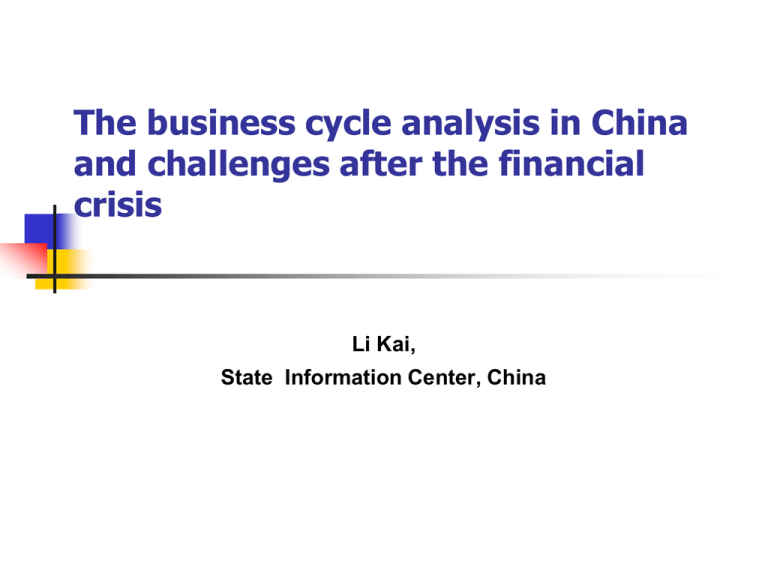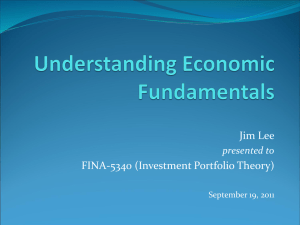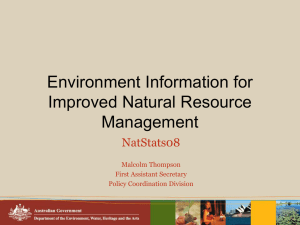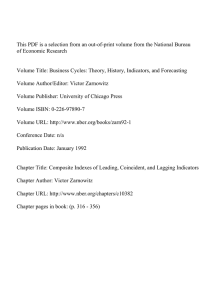The business cycle analysis in China and challenges after the financial crisis
advertisement

The business cycle analysis in China and challenges after the financial crisis Li Kai, State Information Center, China Content Progress of business cycle analysis in China Challenges in business cycle analysis Chinese BI faces after the financial crisis Progress of business cycle analysis in the China Study on business cycle in China started relatively late, just from late 1980’s. Major providers and publishers include: Central bank, saving customer survey, economist survey and industrial company survey; NBS, survey on industrial and service firms from late 90’s; consumer surveys; Information Center of commerce, PMI based on business survey; NDRC, monthly workshop joined by 7 business cycle analysis providers; SIC, quarterly business survey on 5000 manufactures from 1990s; monthly business cycle analysis from 2004, publish leading and coincident index monthly. Application of business cycle analysis in the China Now, business cycle index are published regularly in China by different agencies on price, investment, consumption, saving, foreign trade and performance of leading industries. Additionally over 30 provinces and cities publish relevant regional business cycle index regularly as well. Basic procedures of composing CI and DI by SIC Key steps in composing index 指标的选取 selection of component indicators 数据的处理 data processing, seasonal adjustment 基准周期的确定 setting up the baseline cycles 景气指数的生成 composition of business cycle indicators 先行、同步和滞后指标(指数)的确定 set up Leading, Coincident and Lagging indicators 景气变动趋势预测 forecast of economic trend 警度的确定 determination of warning criteria Major components of the macro business cycle index by SIC Leading Index Coincident Index 1.financial institutions loans 1. Industrial Added Value (Comparable Price) 2. New project in fixed assets construction 2.Power Generation Production 3. Money supply (M1) 3.Total Volume of Fixed Assets Investment 4. Cash flow by industrial producers 4.Fiscal Revenue 5. Final product inventory 5. Export Growth 6. Output of steel, automobile 6. Sale of consumer goods Challenge1 BCI faces after the financial crisis Economic restructuring changes properties of component indicators, and their relationship. Major economic changes: demographic dividend declining, industrial promotion, service sector enhancing, trade balanced, urbanization, western region Development, etc. Challenge 2 in China after the financial crisis “Stimulate” policy impacts more prominent with shorter term of leading index, which makes the lagging term between LI & CI shorter. Shorter term between LI & CI leading Index (red) , coincident index (blue) Ⅲ challenges China face post-crisis The impact of macro-economic policy in the business cycle index exists and grows to be more prominent in the past economic crises. For example, the leading term of leading index is 8 months in 1997-2008. However, after the proactive macro-economic policies were adopted in response to the global financial crisis by the Chinese government, during 2008 to 2011, the leading period of leading index is only 2 months. By now, the period has recovered into 5 months with diluted impacts of stimulating policies. It should be noted that the change of leading term of leading index can affect the prediction accuracy of business cycle index. Challenge 3 in China after the financial crisis Overlapping of three cycles brings difficulties to follow the past criteria for monitoring and warning the economy. Monitoring index of macro-economy Comprehensive monitoring index Ⅲ challenges China face post-crisis In the post-crisis period, Chinese economy is now facing transformation from higher growth into a medium rate of economic growth with profound changes in lower saving rate, fewer labor supply, accelerating urbanization, less spillover effect of foreign trade and increasing constraints on environment. The limit set of monitoring system may face a dilemma against such a context, that is, how to balance between the current economic situation and the observation in a historic view. Thank you!



